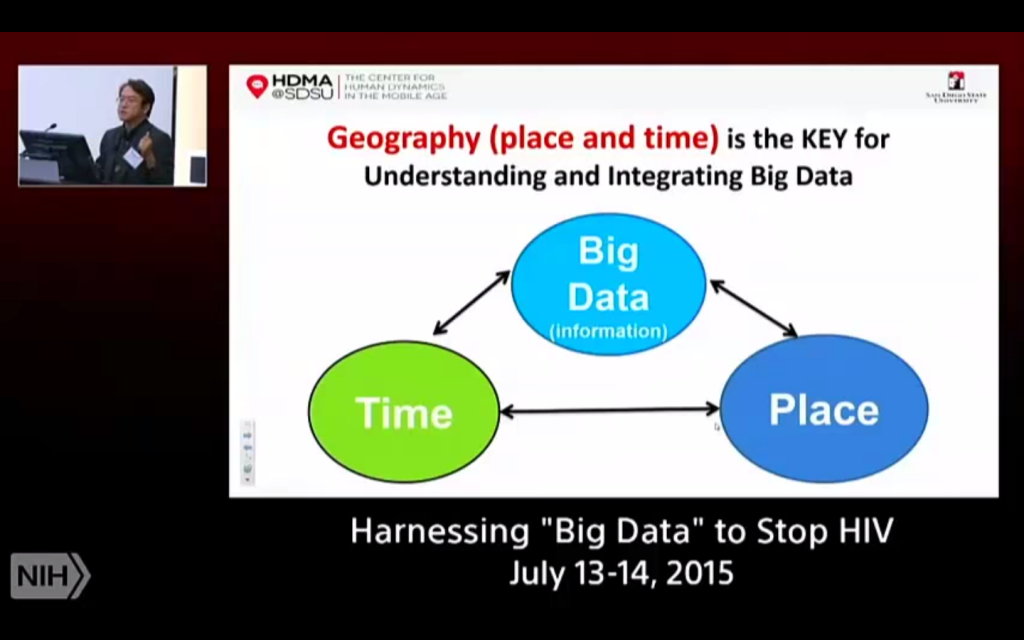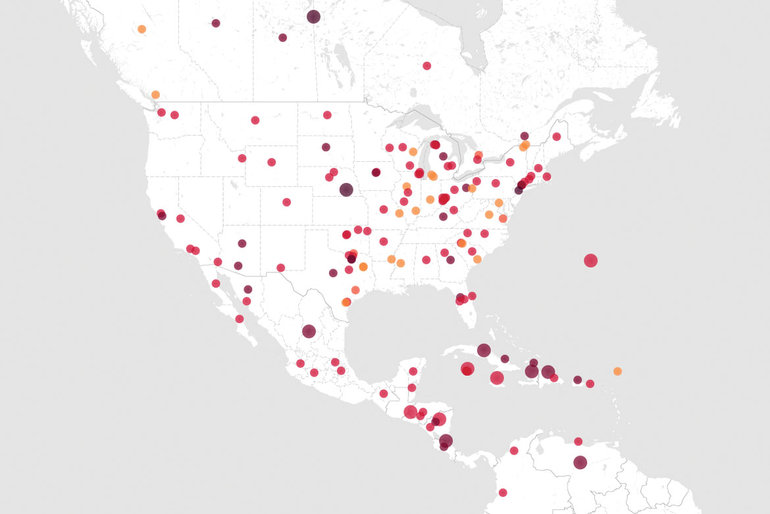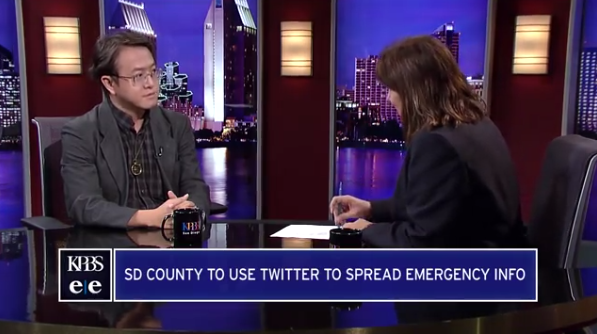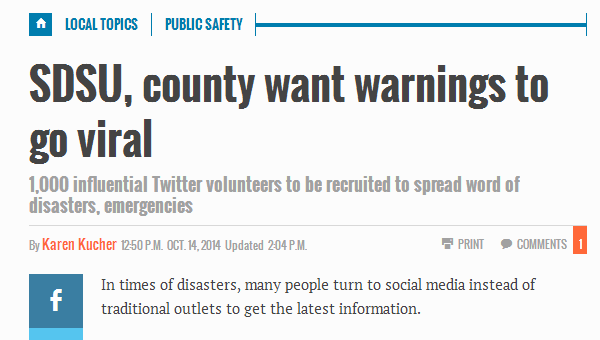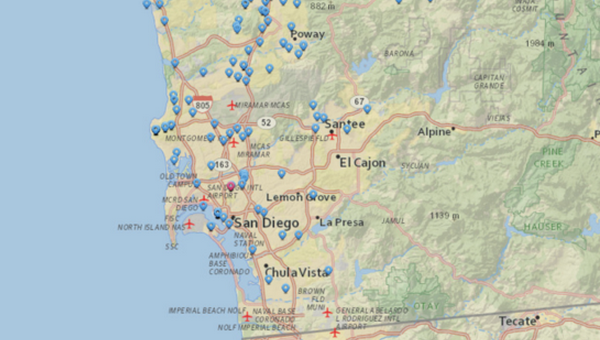National Institutes of Health July 13- 14, 2015, Twitter and Social Media in Public Health Research
NIH Conference Title: Harnessing Big Data to Stop HIV (source: NIH).
There is a great opportunity for geographers and GIS specialists to collaborate with public health researchers and practitioners to develop comprehensive research framework, web maps, and visualization tools to promote health behaviors, detect disease outbreaks, and prevent health problems. This webinar will discuss the impacts of big data and social media to disease outbreak surveillance and health disparities problems. Several web applications developed by the Center of Human Dynamics in the Mobile Age (HDMA) at San Diego State University will be introduced to demonstrate the value of social media analytics, including SMART dashboard for city-level flu outbreak monitoring tasks and GeoViewer for studying environmental-behavioral interactions (source: iDash).
Emergency Management Jan. 20, 2015, Can You Make Disaster Information Go Viral?
San Diego County and San Diego State University (SDSU) recently formed a partnership to research and develop a new social media-based platform for disseminating emergency warnings to citizens. The project aims to allow San Diego County’s Office of Emergency Services (OES) to spread disaster messages and distress calls quickly and to targeted geographic locations, even when traditional channels such as phone systems and radio stations are overwhelmed (source: Emergency Management).
KentWired Jan. 15, 2015, Kent State Searches to Find Relations between Social Media and Crisis
Ye, geography professor Jay Lee and associate computer science professor Ruoming Jin were given $300,000 from the National Science Foundation to carry out their research. Kent State is working along with San Diego University and the University of Arkansas as part of a $999,887 grant (source: KentWired).
Government Technology Jan. 7, 2015, Using Social Media Data to Identify Outbreaks and Control Disease
Could infectious disease surveillance systems that accurately track social media data inform early warning systems and outbreak response? (source: GovTech)
WKSU Dec. 11, 2014, Kent State Researchers Get a Grant to Study Social Media and Disasters
Geography professor Jay Lee and his team will use the $300,000 National Science Foundation grant to create programs to sort store and interpret tweets about disasters (source: WKSU).
Kent State University Dec. 10, 2014, Kent State Researchers to Study Social Media Use During Crises and Disasters
The National Science Foundation (NSF) has awarded Kent State University a $300,000 grant for three College of Arts and Sciences faculty members to study how human dynamics across social media and social networks can be modeled. The grant is part of a $999,887 collaboration with San Diego State University and the University of Arkansas (source: Kent State University).
The Daily Aztec Dec. 10, 2014, Researchers Track Flu through Twitter
San Diego State geography professor Ming-Hsiang Tsou and fellow SDSU researchers have begun using Twitter as a surveillance tool to track seasonal influenza (source: The Daily Aztec).
UARK Newswire Dec. 3, 2014, Geoinformatics Professor Awarded Nearly $100,000 Grant for Human Dynamics Study
Xuan Shi, an assistant professor of geoinformatics at the University of Arkansas, has been awarded a nearly $100,000 grant to study human dynamics across social media and social networks (source: UARK Newswire).
CBS8News-San Diego Oct. 20, 2014, SDSU professor to use Twitter to alert San Diegans
SAN DIEGO (CBS 8) – Have you ever wondered why certain tweets or Facebook posts go viral, and others get no interest whatsoever? A research team at San Diego State University has just received a $1 million grant from the National Science Foundation to answer that question, and then use that information to help protect San Diegans (source: CBS8News-San Diego).KPBS Oct. 15, 2014, SDSU Professor Selecting ‘Tweeters’ To Spread Emergency Messages
Ming-Hsiang Tsou, an SDSU geography professor, is compiling a list of 1,000 influential Twitter accounts based in San Diego, so emergency messages about evacuations, road closures and the like can be spread faster or targeted more closely to certain locations (source: KPBS).Phys.org Oct. 14, 2014, Viral messaging research leads to Twitter-based emergency warning system
San Diego County is partnering with San Diego State University to develop a new social media–based platform for disseminating emergency warnings to San Diego citizens (source: Phys.org).SDSU Newscenter Oct. 13, 2014, Going Viral with Emergency Warnings
San Diego County is partnering with San Diego State University to develop a new social media–based platform for disseminating emergency warnings to San Diego citizens (source: SDSU Newscenter).FOX5-San Diego Oct. 13, 2014, SDSU looks for influential ‘tweeters’ to spread county’s emergency messages
SAN DIEGO – Official emergency messages for San Diego County might be spread in the future by the most influential “tweeters,” San Diego State University announced Monday (source: FOX5-San Diego).KUSI Oct. 13, 2014, San Diego’s influential Twitter users to spread emergency messages
SAN DIEGO (CNS) – Official emergency messages from the county of San Diego in the future might be spread by the region’s most influential “tweeters,” San Diego State University announced Monday (source: KUSI).
